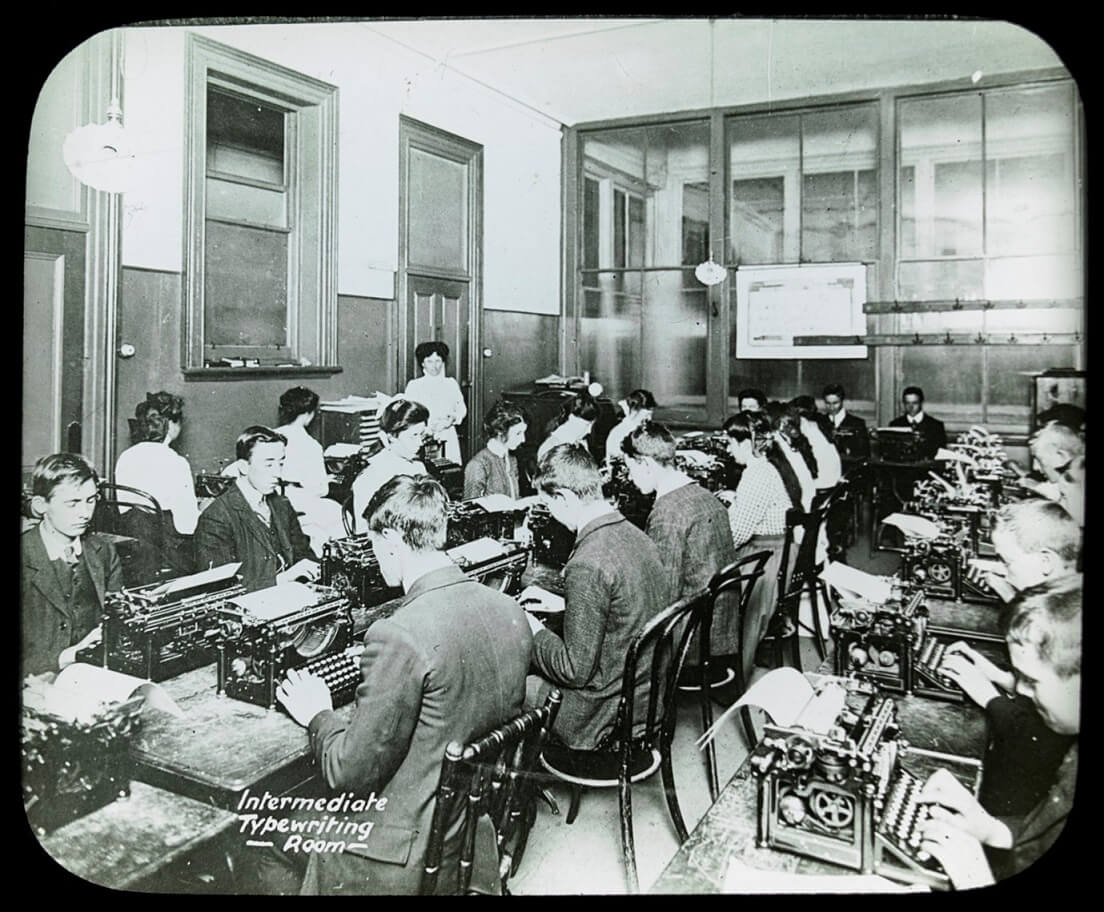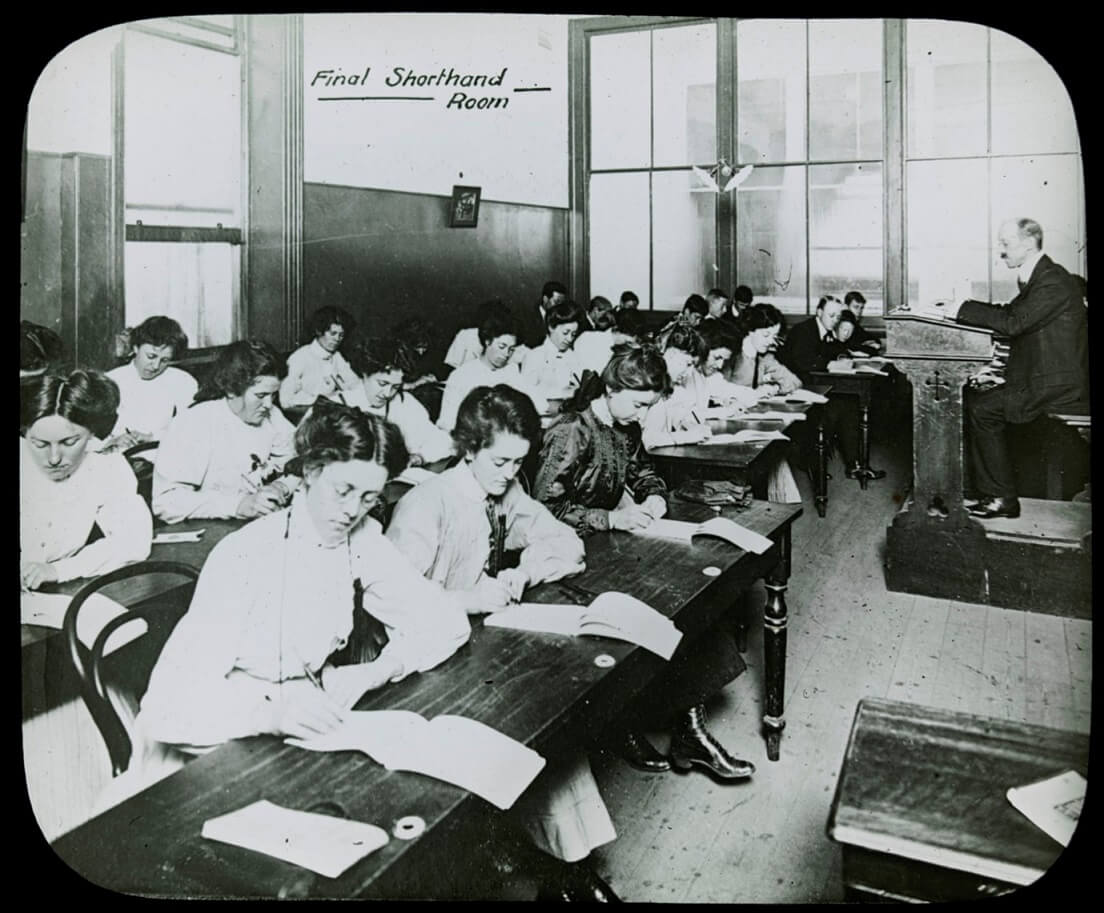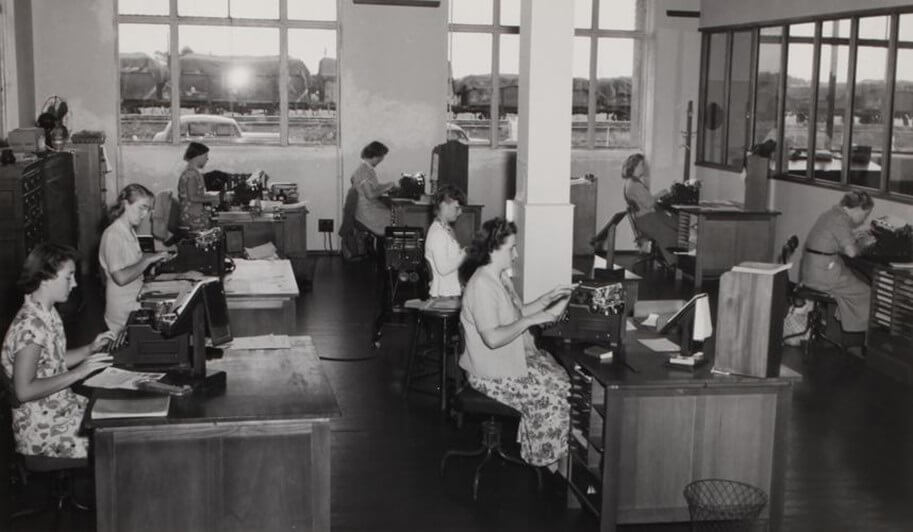The typewriter was the other important nineteenth-century invention to invade the office. Although the first commercial machines were produced in the United States in the 1870s, business was at first reluctant to use them, preferring the personal touch of the hand-written letter. There was also some suspicion about an increased risk of forgery. But the efficiency offered by the new machines soon won over even the most conservative business owner, and from the 1880s the typewriter became as much a fixture in the office as the telephone. The day of the hand copyist was over. Some copyists may well have retrained as typewriters, for the name of the machine was synonymous with its operator at first, and the first ‘typewriters’ were usually men. Women soon learned to type very efficiently however and increasingly came to dominate typewriting classes in courses like those run by Stott’s Business College in Melbourne. As before, business began to employ female typewriters because they were cheaper and did the job equally well. In time, a new term emerged to describe those who operated typewriters, replacing the ungendered ‘typewriter’ with the feminised ‘typist’, and heralding the arrival of a new group of female workers in the office.
Intermediate Typewriting Room, Stott’s Business College, 1910
Reproduced courtesy State Library Victoria
In this typewriting class at Stott’s Business College in 1910, most of the pupils seem to be boys. Later typing was taught almost exclusively to girls.
The typewriter not only speeded up the production of business correspondence, it developed the capacity to create copies at the same time. This was achieved by placing a sheet of thin carbonised paper between the top copy of a document and a thin piece of copy paper underneath. ‘Carbon copies’ was a new term used to describe these duplicate documents, which still survive (albeit often in a fragile state) in archives.
Accuracy in typing was, of course, of utmost importance, especially in legal documents. When my sister trained as a legal secretary in the early 1970s there could be no mistakes whatever in a legal document. A single mistake meant that the entire page had to be retyped — a fair incentive for concentration! It is hard to imagine the skill involved in achieving this standard of accuracy now that our work can be typed, corrected and moved about as we please on modern computers, but spare a thought for the academic typist too. She (it was inevitably ‘she’,) had not only to type the content, but place the footnotes accurately, allowing sufficient space (but not too much) at the bottom of each page. And woe betide any scholar who thought, belatedly, to add a reference! My sister kindly typed my honours thesis for me, along with the two carbon copies then required. It was a labour of love indeed!
Typewriters created type on the page by hitting keys, which struck the page through an inked typewriter ribbon, moving along the page from left to right. The ribbon spooled progressively as it was used and was replaced once used up. The paper was wound through the roll (paten) set on a carriage above the keyboard and was held in place by pressure. The typist would set tabs on the keyboard to indicate the paper size and set the required margins. As she approached the end of the set line on the page the typewriter would sound a bell, warning the typist that she needed to ‘return’ the typewriter carriage to the left again, in a movement that also advanced the paper to the next line. Leroy Anderson‘s humorous musical composition of 1953, aptly named the ‘The Typewriter’, captured the sounds made by the typewriter perfectly. A real typewriter was used in performance, ‘played’, with considerable skill, by one of the percussionists. It is a reminder that typing rooms must have been noisy workplaces.
‘Touch’ typing
The letters on the popular early Remington typewriters were arranged in three tiers and placed so that those used most were struck by the strongest fingers. The resulting QWERTY keyboard as it was known is still the standard for computer keyboards using Latin scripts. Professional typists learned to ‘touch type’, so called because they did not watch the keyboard, but kept their eyes on whatever document they were typing. This allowed them to type both quickly and accurately. They used all four fingers to depress the keys, overlapping in the central keys with the second finger. The thumbs were used for the space bar. Typing schools often used covered keyboards to force their students to memorise the location of the keys, which followed no obvious sequence. The keys on these ‘manual’ typewriters also required some force to engage and typists developed strong finger muscles, but they did not tend to suffer from the repetitive strain injuries that came with the electric typewriters and computer keyboards that followed. These required so little effort to depress the keys that the typist could achieve quite astonishing speeds, but the resulting over-use of tendons in the forearms, wrists and fingers could cause injury.
Shorthand typists
Most business schools taught their students both shorthand and typing. Shorthand was a system of abbreviations, lines and symbols, based on phonetic spelling, that allowed the rapid recording of the spoken word, generally during dictation. It was used extensively in offices for correspondence and drafting legal documents, in Parliament to record Hansard, by court reporters and by journalists. Students had first to learn the language itself and then work on their speed and accuracy. For many years the ability to take dictation at 100 words per minute was regarded as the minimum standard for a proficient shorthand writer, though many jobs required a higher standard than this. Court reporters and Hansard writers required shorthand speeds of between 160 and 180 words per minute, with a commensurate level of accuracy. In Britain and Australia Pitman’s shorthand was the most common form taught, but there were other languages in use elsewhere. Shorthand writers used pencils and small shorthand notebooks to take dictation, then typed from their notebooks to create the required documents. It was a skilled occupation, that was taught until the late-twentieth century. Thereafter it dwindled and finally disappeared, to be replaced by various recording devices and increasingly now by mobile phones.
Final Shorthand Room, Stott’s Business College, 1910.
Reproduced courtesy State Library Victoria
Although the students in the foreground of this photograph are all young women, there are also several rows of men in the background.
The typing pool
Most young shorthand typists began their working lives in a typing pool — a room in which typists sat at small, individual desks, processing work allocated by a head typist. The head typist was the intermediary between office workers requiring documents to be typed and the typists themselves. Work was allocated on the basis of receipt, urgency or seniority: only a minority of senior executives generally had their own shorthand typists (then described as secretaries, or private secretaries). Becoming a private secretary was the goal of many in the typing pool and often the only promotion available. The head typist was usually a senior woman with extensive experience, who managed both workflow and work standards. Depending on the office, she might also enforce a corporate dress code and oversee standards of behaviour, including punctuality and attendance. In this sense the typing pool was a bit like a school classroom, with the head typist often cast in the guise of head teacher. She not infrequently shielded her typists from pressure to reorder work priorities, or from other unwanted male attention, sometimes acquiring a formidable reputation amongst young men in the office. But for all her authority, the head typist was often paid less than a junior clerk. As late as 1969 the work of the shorthand typist was classed as women’s work and paid accordingly, while even inexperienced junior clerks were paid a full ‘male’ wage. In the public service, typists were placed in the lowest rank of classifications, with no hope of progression to higher classifications.



